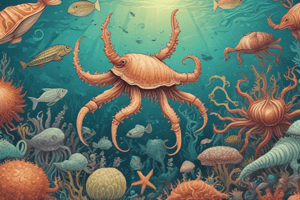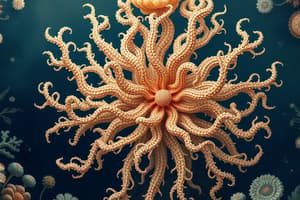Podcast
Questions and Answers
Which of the following is NOT a characteristic of mollusks?
Which of the following is NOT a characteristic of mollusks?
- They have a shell made of calcium carbonate.
- They have a soft body.
- They have a radula for scraping food.
- They have an exoskeleton made of chitin. (correct)
All cephalopods have an external shell.
All cephalopods have an external shell.
False (B)
What is the name of the specialized feeding structure found in sea urchins?
What is the name of the specialized feeding structure found in sea urchins?
Aristotle's lantern
The phylum ______ is characterized by having a water vascular system used for respiration, feeding, locomotion, and waste transportation.
The phylum ______ is characterized by having a water vascular system used for respiration, feeding, locomotion, and waste transportation.
Match the following classes of arthropods with their representative examples:
Match the following classes of arthropods with their representative examples:
Which of the following is a characteristic of horseshoe crabs?
Which of the following is a characteristic of horseshoe crabs?
Sea stars can regrow lost limbs, but only if the central disk is also damaged.
Sea stars can regrow lost limbs, but only if the central disk is also damaged.
What is the name of the structure that connects to the 'mother pore' (madreporite) in the water vascular system of echinoderms?
What is the name of the structure that connects to the 'mother pore' (madreporite) in the water vascular system of echinoderms?
The ______ is the part of the octopus's body that helps it escape predators by releasing ink.
The ______ is the part of the octopus's body that helps it escape predators by releasing ink.
Which of the following is a characteristic shared by both cephalopods and mollusks?
Which of the following is a characteristic shared by both cephalopods and mollusks?
What percentage of animals are invertebrates?
What percentage of animals are invertebrates?
Sponges are the simplest multicellular animals.
Sponges are the simplest multicellular animals.
What is the name of the specialized cells responsible for generating water currents in sponges?
What is the name of the specialized cells responsible for generating water currents in sponges?
The type of symmetry found in starfish is called ______ symmetry.
The type of symmetry found in starfish is called ______ symmetry.
Which of these organisms is an example of a cnidarian?
Which of these organisms is an example of a cnidarian?
What is the name of the stinging cells found in cnidarians?
What is the name of the stinging cells found in cnidarians?
Cnidarians have a complete digestive system.
Cnidarians have a complete digestive system.
What is the free-floating form of a cnidarian called?
What is the free-floating form of a cnidarian called?
Match the following cnidarian classes with their respective examples:
Match the following cnidarian classes with their respective examples:
Which class of cnidarians is known for its box-shaped bell and highly venomous nematocysts?
Which class of cnidarians is known for its box-shaped bell and highly venomous nematocysts?
The structure used by gastropods for grazing on plants is called a ______.
The structure used by gastropods for grazing on plants is called a ______.
All gastropods have shells.
All gastropods have shells.
What is the name of the class of molluscs that includes clams, oysters, scallops, and mussels?
What is the name of the class of molluscs that includes clams, oysters, scallops, and mussels?
Which of these statements is true regarding the circulatory system of molluscs?
Which of these statements is true regarding the circulatory system of molluscs?
The symbiotic algae found in the tissues of many coral species are called ______.
The symbiotic algae found in the tissues of many coral species are called ______.
Flashcards
Bivalvia
Bivalvia
A class of mollusks that have two shells or valves.
Umbo
Umbo
The oldest part of a bivalve shell.
Cephalopoda
Cephalopoda
A class of mollusks with a head-foot arrangement, including squids and octopuses.
Arthropods
Arthropods
Signup and view all the flashcards
Decapoda
Decapoda
Signup and view all the flashcards
Merostoma
Merostoma
Signup and view all the flashcards
Echinodermata
Echinodermata
Signup and view all the flashcards
Water Vascular System
Water Vascular System
Signup and view all the flashcards
Asteroidea
Asteroidea
Signup and view all the flashcards
Holothuroidea
Holothuroidea
Signup and view all the flashcards
Invertebrates
Invertebrates
Signup and view all the flashcards
Symmetry Types
Symmetry Types
Signup and view all the flashcards
Phylum Porifera
Phylum Porifera
Signup and view all the flashcards
Choanocyte
Choanocyte
Signup and view all the flashcards
Ostia
Ostia
Signup and view all the flashcards
Phylum Cnidaria
Phylum Cnidaria
Signup and view all the flashcards
Medusa
Medusa
Signup and view all the flashcards
Polyp
Polyp
Signup and view all the flashcards
Nematocyst
Nematocyst
Signup and view all the flashcards
Digestive System (Cnidarians)
Digestive System (Cnidarians)
Signup and view all the flashcards
Phylum Mollusca
Phylum Mollusca
Signup and view all the flashcards
Class Gastropoda
Class Gastropoda
Signup and view all the flashcards
Asexual Reproduction (Sponges)
Asexual Reproduction (Sponges)
Signup and view all the flashcards
Hermaphrodites
Hermaphrodites
Signup and view all the flashcards
Study Notes
Invertebrate Diversity in Marine Environments
- Invertebrates are animals without a backbone, while vertebrates have one.
- 97% of all animals are invertebrates.
- Marine environments host representatives from all major animal groups.
- Some animal groups are exclusively marine.
Invertebrate Characteristics
- Multicellular and diploid organisms with tissues, organs, or organ systems.
- Heterotrophic (obtain energy from other organisms).
- Require oxygen for aerobic respiration.
- Reproduce sexually, asexually, or both.
- Most are motile (move) at some point in their life cycle.
- Life cycles involve embryonic development.
Types of Symmetry
- Asymmetrical: No plane of symmetry (e.g., sponges).
- Radial symmetry: Central axis, many planes of symmetry (e.g., starfish).
- Bilateral symmetry: One plane of symmetry (e.g., sea turtles).
Phylum Porifera (Sponges)
- Aggregations of specialized cells, not true tissues.
- Simplest multicellular animals.
- Almost all are marine and sessile (permanently attached).
- Tiny pores (ostia) allow water to flow through to filter feed on plankton and dissolved organic matter.
- Water flow also removes waste and carries gametes.
- Choanocytes (collar cells) are essential for water current generation.
- Pinacocytes and porocytes form the outer surface, and choanocytes line feeding chambers.
- Water exits through the osculum.
- Can reproduce sexually or asexually, and some species are hermaphrodites.
- Spicules (siliceous or calcareous structures) or spongin fibers provide structural support.
Phylum Cnidaria (Stinging Animals)
- Radial symmetry.
- Mostly marine with two body forms:
- Medusa: Free-floating, mouth and tentacles downward.
- Polyp: Sessile, mouth and tentacles upward.
- Two tissue layers (epidermis and gastrodermis) surround a gelatinous mesoglea.
- Capture prey using nematocysts (stinging cells).
- Incomplete digestive system (sac-like with one opening).
- Nerve net coordinates movement.
- Reproduction includes sexual (medusa stage producing gametes) and asexual (polyp buds).
Classes of Cnidarians
- Class Anthozoa: Corals, anemones, sea whips, solitary or colonial polyps, lack a medusa stage. Many have symbiotic algae (zooxanthellae).
- Class Hydrozoa: Colonies of polyps, small medusae. Includes siphonophores (e.g., Portuguese man-of-war).
- Class Scyphozoa: Jellies (e.g., sea nettles, moon jellies, lion's mane jellyfish).
- Class Cubozoa: Box jellies with box-shaped bell and four tentacles. Neurotoxic nematocysts.
Phylum Mollusca (Soft-bodied Animals)
- Includes diverse groups like gastropods, bivalves, and cephalopods.
- Gastropods (e.g., snails) and some cephalopods have a radula for feeding.
- Bivalves (e.g., clams, oysters) have two shells and use gills for filter feeding.
- Cephalopods (e.g., squid, octopus) are highly intelligent, with advanced eyes and a closed circulatory system. They use a powerful beak and radula, and some have ink sacs and camouflage.
Phylum Arthropoda (Jointed-legged Animals)
- Largest phylum of animals. Marine arthropods are largely crustaceans.
- Segmented bodies, jointed appendages, and exoskeletons of chitin.
- Must molt to grow.
Subphylum Crustacea
- Crustaceans – 68,000 known species.
- Copepods, barnacles, amphipods (small crustaceans found widely, including in plankton).
- Decapods (e.g., shrimps, lobsters, crabs) – 10 legs, cephalothorax, and abdomen.
Class Merostomata (Horseshoe Crabs)
- “Living fossils.”
- Important in medical research (limulus amebocyte lysate test).
Phylum Echinodermata (Spiny-skinned Animals)
- Bilateral symmetry (early developmental stage), then radial symmetry.
- Internal endoskeleton of calcium carbonate ossicles.
- Water vascular system for respiration, feeding, locomotion, and waste removal.
- Includes sea stars (Asteroidea), sea urchins (Echinoidea), sea cucumbers (Holothuroidea).
General Study Guide for Marine Invertebrates
| Phylum | Class | Genus/Species |
|---|---|---|
| Porifera | ||
| Cnidaria | Anthozoa, Hydrozoa, Scyphozoa, Cubozoa | Physalia physalis |
| Aurelia aurita, Chrysaora quinquecirrha, Cyanea capillata, Drymonema dalmatinum | ||
| Mollusca | Gastropoda, Bivalvia, Cephalopoda | |
| Arthropoda | Crustacea (Decapoda, Merostomata) | |
| Echinodermata | Asteroidea, Echinoidea, Holothuroidea | Asterias vulgaris, Lytechinus variegatus, Cucumaria frondosa |
Studying That Suits You
Use AI to generate personalized quizzes and flashcards to suit your learning preferences.




